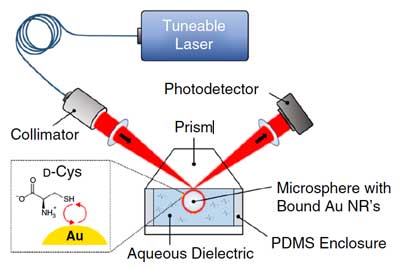| May 06, 2020 | |
Eavesdropping on single molecules with light by replaying the chatter |
|
| (Nanowerk Spotlight) The structure of individual molecules and their properties, such as chirality, are difficult to monitor in real time. It turns out that by temporarily bridging molecules together we can provide a lens into their dynamics. | |
| A study led by Prof. Frank Vollmer at the University of Exeter’s Living Systems Institute has exposed new pathways for investigating biochemical reactions at the nanoscale. Thiol/disulfide exchange at equilibrium has not yet been fully scrutinised at the single-molecule level, in part because this cannot be optically resolved in bulk samples. | |
| Light can, however, circulate around micron-sized glass spheres to form resonances. The trapped light can then repeatedly interact with its surrounding environment. By attaching gold nanoparticles to the sphere, light is enhanced and spatially confined down to the size of viruses and amino acids. | |
| The resulting optoplasmonic coupling allows for the detection of biomolecules that approach the nanoparticles while they attach to the gold, detach, and interact in a variety of ways. | |
| Despite the sensitivity of this technique, there is lacking specificity. Molecules as simple as atomic ions can be detected and certain dynamics can be discerned, yet we cannot necessarily discriminate them. | |
| The breakthroughs reported in Nature Communications ("Optoplasmonic characterisation of reversible disulfide interactions at single thiol sites in the attomolar regime") have proceeded to amend this. | |
 |
|
| Optoplasmonic sensor setup and quantification of adsorbing D-cysteine. Scheme for LSP-WGM (localised surface plasmon - whispering-gallery mode) based sensing. A beam emitted from a tuneable laser source, with central wavelength of 642 nm, is focused onto a prism face to evanescently couple to a microspherical WGM cavity. The WGM excites the LSPs of Au NRs on the cavity surface and the hybrid system’s transmission spectrum is acquired at the output arm of the setup. D-cysteine (D-Cys) analytes have carboxyl, thiol, and amine groups. (© Nature Communications) | |
| Reaction pathways regulated by disulfide bonds can constrain interactions to single thiol sensing sites on the nanoparticles. The high fidelity of this approach establishes precise probing of the characteristics of molecules undergoing the reaction. | |
| By placing linkers on the gold surface, interactions with thiolated species are isolated for based on their charge and the cycling itself. | |
| Sensor signals have clear patterns related to whether reducing agent is present. If it is, the signal oscillates in a controlled way, while if it is not, the oscillations become stochastic. For each reaction the monomer or dimer state of the leaving group can be resolved. | |
| Surprisingly, the optoplasmonic resonance shifts in frequency and/or changes in linewidth when single molecules interact with it. In many cases this result suggests a plasmon-vibrational coupling that could help identify individual molecules, finally achieving characterisation. | |
| "This excellent work by my PhD student, Serge Vincent, paves the way for many future single-molecule analysis techniques that we have only been dreaming about," Professor Frank Vollmer adds. "It is a crucial step for our project ULTRACHIRAL. ULTRACHIRAL seeks to develop breakthroughs in how we use light to analyse chiral molecules." | |
|
Provided by the University of Exeter
|
|
|
Become a Spotlight guest author! Join our large and growing group of guest contributors. Have you just published a scientific paper or have other exciting developments to share with the nanotechnology community? Here is how to publish on nanowerk.com. |
|
